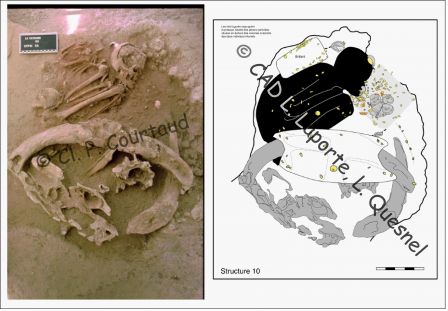Dupont C., Laporte L., Courtaud P., Duday H., Gruet Y., 2014– « Personal shell adornments » ? at La Vergne (Charente-Maritime, France): from acquisition to wear
Par Catherine Dupont le samedi 22 novembre 2014, 17:58 - Zoom sur publications - Lien permanent
Dupont C., Laporte L., Courtaud P., Duday H., Gruet Y., 2014– « Personal shell adornments » ? at La Vergne (Charente-Maritime, France): from acquisition to wear. In: Szabó K., Dupont C., Dimitrijevic V., Gastélum Gómez L. G., Serrand N., (eds.), Archaeomalacology: Shells in the Archaeological Record. Proceedings of the 11th ICAZ International Conference. Paris - Archaeomalacology Working group, 23-28 August 2010, France, BAR International Series 2666. Archeopress, Oxford, ISBN 978 1 4073 1308 5. 43-52.

Spatial distribution of perforated shells in grave 10 at La Vergne (Charente-Maritime) – Cl. P. Courtaud, CAD L. Laporte, L. Quesnel
Abstract
More than three thousands perforated shells have been discovered in association with Early Mesolithic burials (ca. 8500-8000 cal BC) at La Vergne (Charente-Maritime, western France). In spite of the status of this excavation, an archaeological rescue operation, all artefacts have been dimensioned in space and oriented. We will see that this first stage of the study of shell is fundamental to understand how these adornments were associated with human bodies. The determination of species used is also important to know where and how these shells have been gathered. Their state of surface allows to made difference between marks linked to marine erosion, animal and anthropic perforations. Identification of use marks and their degree of wear linked to spatial data authorize reconstitution of not only body ornaments but also of objects associated with human during their funeral. This paper presents a complete view of the different stages of the study of ornaments at La Vergne burials from excavation to the reconstitution of associated shells in space.
Commentaires